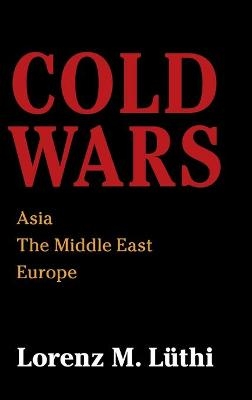
Cold Wars
Cambridge University Press (Verlag)
978-1-108-41833-1 (ISBN)
What was the Cold War that shook world politics for the second half of the twentieth century? Standard narratives focus on Soviet-American rivalry as if the superpowers were the exclusive driving forces of the international system. Lorenz M. Lüthi offers a radically different account, restoring agency to regional powers in Asia, the Middle East and Europe and revealing how regional and national developments shaped the course of the global Cold War. Despite their elevated position in 1945, the United States, Soviet Union and United Kingdom quickly realized that their political, economic, and military power had surprisingly tight limits given the challenges of decolonization, Asian-African internationalism, pan-Arabism, pan-Islamism, Arab–Israeli antagonism, and European economic developments. A series of Cold Wars ebbed and flowed as the three world regions underwent structural changes that weakened or even severed their links to the global ideological clash, leaving the superpower Cold War as the only major conflict that remained by the 1980s.
Lorenz M. Lüthi is Associate Professor at McGill University, Montréal, and is a leading historian of the Cold War. His first book The Sino-Soviet Split: Cold War in the Communist World (2008) won the 2008 Furniss Award and the 2010 Marshall Shulman Book Prize. His publications on the Vietnam war, Asian-African internationalism, and non-alignment have broken new ground in Cold War history.
Introduction; 1. From high imperialism to Cold War division; Part I. Elusive Unities: Introduction to chapters 2 to 4; 2. The United Kingdom and the Arab League; 3. The Soviet Union and the socialist camp; 4. The United States and the free world; Part II. Asia: Introduction to chapters 5 to 7; 5. China; 6. Vietnam; 7. India; Part III. The Middle East: Introduction to chapters 8 to 10; 8. Arab-Israeli relations, 1948–64; 9. Arab-Israeli relations, 1964–75; 10. The Palestinians; Part IV. Alternative World Visions: Introduction to chapters 11 to 13; 11. Asian-African internationalism; 12. Non-alignment; 13. Pan-Islamism; Part V. Europe between the Superpowers: Introduction to chapters 14 to 16; 14. Nuclear weapons; 15. West European integration; 16. The Council for Mutual Economic Assistance; Part VI. European Détente: Introduction to chapters 17 to 19; 17. Germany; 18. The Conference on Security and Cooperation in Europe; 19. The Vatican; Part VII. The End of the Regional Cold Wars: Introduction to chapters 20 to 22; 20. The Middle East; 21. Asia; 22. Europe; 23. The end of the Superpower Cold War; 24. Legacies of the Cold War; Conclusion.
| Erscheinungsdatum | 14.03.2020 |
|---|---|
| Zusatzinfo | Worked examples or Exercises; 10 Maps |
| Verlagsort | Cambridge |
| Sprache | englisch |
| Maße | 157 x 235 mm |
| Gewicht | 1190 g |
| Themenwelt | Geschichte ► Allgemeine Geschichte ► Neuzeit (bis 1918) |
| Geschichte ► Allgemeine Geschichte ► Zeitgeschichte | |
| Sozialwissenschaften ► Politik / Verwaltung ► Europäische / Internationale Politik | |
| ISBN-10 | 1-108-41833-3 / 1108418333 |
| ISBN-13 | 978-1-108-41833-1 / 9781108418331 |
| Zustand | Neuware |
| Haben Sie eine Frage zum Produkt? |
aus dem Bereich


